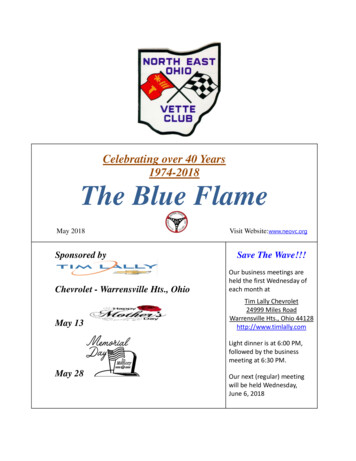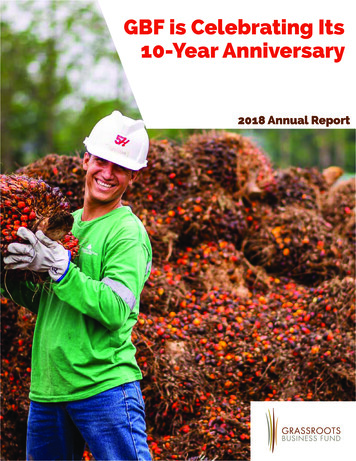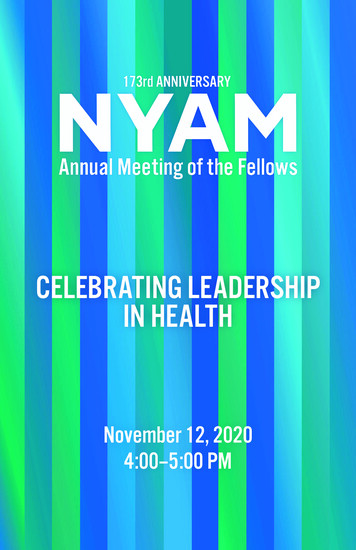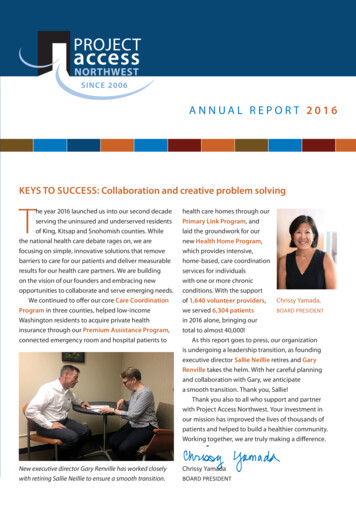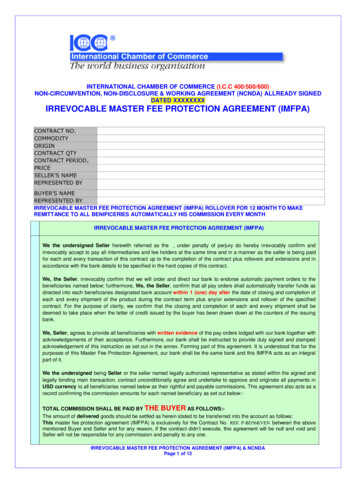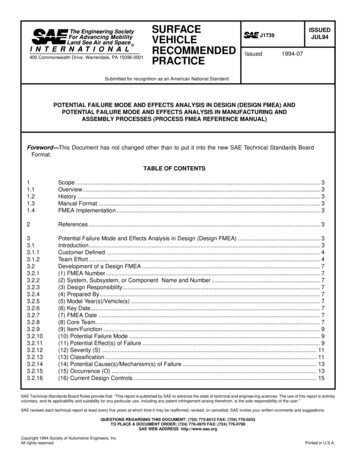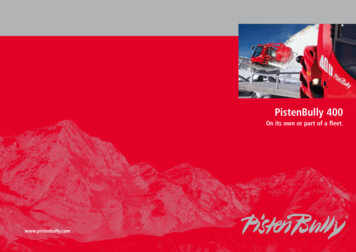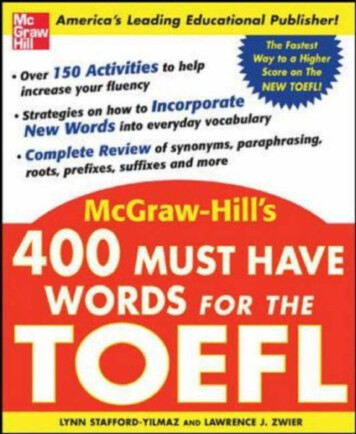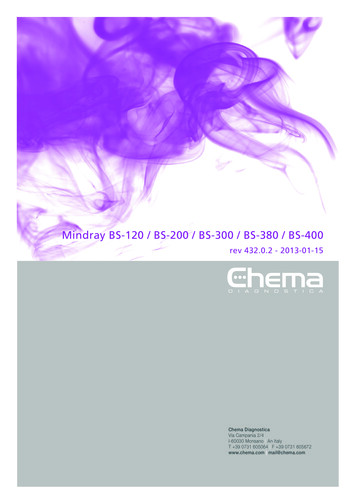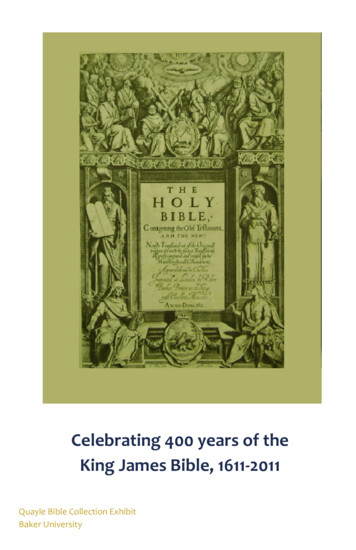
Transcription
Celebrating 400 years of theKing James Bible, 1611-2011Quayle Bible Collection ExhibitBaker University
Six companies of scholars and theologians came togetherat the invitation of King James I of England in 1604, at amost propitious moment. The initial essay in this exhibitbooklet focuses on five streams that converged to flowtoward this literary and theologically grounded translationpublished in 1611. The second essay will set the historicalcontext for the English Bible and the third describes howthe King James Bible, itself, was produced.Five Streams ConvergeThe English Bible could not have developed independently of theEnglish Church, development of the English language, the scholarlyactivity that flourished upon the fall of Constantinople, theReformation, and the invention of printing.The English ChurchLong before Henry VIII broke formally with the church in Rome, relationships between the Church and the secular rulers of Europe werestrained. The Papacy imposed taxes to operate the Church, mountcrusades and fight wars, but as the nations of Europe gained inpower, tension between their rulers and the popes increased.Between 1309 and 1378, the Church hierarchy resided in the southernFrench city of Avignon and the Avignon Popes were French — archenemies of the English. The English found themselves excluded fromthe inner circles of the Church. Even after the church returned toRome, foreign priests were appointed to positions in England, leavingonly lower paid church positions for the English.
Quayle Bible Collection Exhibit,Baker UniversityPage 3Henry’s break with the Church over his divorce was not an unwelcome development in England. The subsequent establishment of anational church opened the doors for the first officially sanctionedtranslation, the Great Bible, which was required to be set in everychurch or chapel , available for any of the King’s subjects to read.The English LanguageParts of the Bible were translated into Old English by Caedmon (7thcentury), Bede (8th century) and Aelric (11th century) among others.However, in 1066, after the Norman Conquest, the French languagesupplanted English as the language of the government and the nobility. It was used well into the 14th century when the French influencebegan to fade. By 1347, French was no longer taught in the schoolsand by 1360, English replaced French as the language of the noblesand governing elite.John Wycliffe wrote and preached in English from the mid-1300’sthrough his death in 1384. The first complete English translation of theBible (written under his name, but not by him) appeared in 1382. Itwas enormously popular; about 250 handwritten copies remain, morethan other English works — including Chaucer’s — before the invention of the printing press.The Fall of ConstantinopleThe early Latin translation made from Hebrew and Greek by Jerome in390-404 was called the Vulgate. For nearly a millennium, Europeanclerics and scholars relied on the Vulgate almost exclusively. With thefall of Constantinople in 1453, scholars fleeing the Ottoman Empirerelocated in Europe, bringing with them previously unknown Hebrewand Greek manuscripts. These texts encouraged the study of Hewbrew and Greek, and scholars like Erasmus and Theodore Beza benefited enormously from them.
Page 4The ReformationReformers such as Martin Luther and John Calvin reacted to the general lack of learning or incompetence of the clergy as well as unjustpractices of the Church. Both of them felt it important that the common people have knowledge of the scriptures so that priest intermediaries were not necessary. Tyndale pressed forward with the ideathat scripture should be the sole basis for Christian doctrine and wasquoted in Foxe’s Book of Martyrs as saying “if God spare my life, eremany years I will cause a boy that driveth the plough shall know moreof the Scriptures than thou doest.”The Printing PressWithout the printing press, reforms might have remained local eventsand new translations might well have had limited impact. The powerof this press took Martin Luther by surprise. A translation of the 95Theses was printed and distributed across Europe in a matter ofmonths. Likewise, Tyndale’s translation was printed in Germany and itis estimated that nearly 18,000 copies were smuggled into England,where it was illegal to own, sell or distribute copies.The printing press also provided scholars with access to many moreresources than they had ever had, including the texts in the originallanguages, lexicons, grammars and other reference books to helpthem make sense of the texts.History of the BibleThe Hebrew ScripturesBetween the 16th and 2nd centuries before Christ, the Hebrew Bibledeveloped as an oral text. During the 8th century BC much literature,including that of Homer, was written down for the first time, andlibraries built to house it. It is likely that many of the books of the Hebrew Bible were written down during that shift from primarily oral towritten literature, but there were objections to writing the
Quayle Bible Collection Exhibit,Baker UniversityPage 5scriptures. Some felt that written scriptures were more susceptible toerrors, physical destruction or malicious corruption than those retained in the memories of the scholars. Others were concerned thatreaders would be distracted by the words and forget to focus on themeaning or wisdom behind them.The canon of the Hebrew Bible was established between 200 BC and200 AD. Beginning just a little earlier, between 300 and 100 BC, thescriptures were first translated into Greek. A substantial Jewish community existed in Alexandria since about 600 BC. After several centuries, they were much more at home speaking Greek than Hebrew, anda group of scholars translated the Hebrew bible into Greek. The workis called the Septuagint, named after the roughly seventy translators— according to legend, seventy-two (six from each of the tribes ofIsrael) — who worked on it.The Christian ScripturesWe think of the Christian Bible as a single volume containing Books ofthe Old and New Testaments, but that was seldom the case until theadvent of printing. Individual books that became the New Testamentwere committed to writing between about 60 AD and 135. Singly andin small groups they were gradually held in greater and greater esteem and, eventually, accorded the authority ofscripture. The Christian Bible as a collection ofthose scriptures took shape over the 4th and 5thcenturies.By the end of the 4th century, there was alreadyconcern that errors had crept into the Bible. Someof the errors were simply mistakes in transcription, but others occurred when notes jotted in ascholar’s text, commentaries and prefaces wereWoodcut of Jerome fromcopied as part of the text itself. Pope Damascusasked the theologian and scholar Jerome to com- the Nurnberg Chroniclepare the best sources in Hebrew and Greek and to make an accurate
Page 6translation into Latin, the common language of western Europe fromabout 200 through 900.The 12th century was marked by a fairly widespread revival of interestin the Biblical text. Both Jewish and Christian scholars were interestedin understanding the original intention of the writers. Christian theologians learned Hebrew to study early manuscripts.In the 14th century a rift developed between reformers , who emphasized the scriptures as the sole source of religious authority, and theestablished church, with its emphasis on tradition. The Wycliffe translations (made by Nicolas Hereford and John Purvey) and subsequenttranslations by William Tyndale, Myles Coverdale, and John Rogers allhad to be copied or printed outside of England and smuggled in withshipments of cloth and other goods.Although the exhibit is concerned mainly with the English forerunnersof the King James Bible, much of the activity took place in continentalEurope. Erasmus completed his Greek New Testament in 1516 andCardinal Cisneros’ Complutensian Polyglot laid the best Greek andHebrew sources at his disposal side-by-side for comparison.European centers of reform included Wittenberg, Hamburg, Zurichand Geneva where the Bible was translated into the common languages of other countries. Luther’s New Testament was published in1522 and the French Bible was translated in 1530 by Jacques Lefebvred’Etaples and 1534 by Pierre Robert Olivetan. The Geneva Bible, whichenjoyed perhaps the longest period of popularity before the KingJames Bible, was completed by English scholars in exile in Geneva.The English BibleWycliffe. The Wycliffe Bible wasn’t printed until 1850, but nearly 180manuscript copies remain in existence. For a book that was banned asheretical and burned in public on several occasions, that is fairly remarkable. No other hand-produced book from that time period existsin that quantity.
Quayle Bible Collection Exhibit,Baker UniversityPage 7John Wycliffe’s name is associated with two translations, neither ofwhich he made himself. Nicholas of Hereford was largely responsiblefor the first and John Purvey for the second. The first translation is aword-for-word translation which is awkward in spots, whereas thesecond is more idiomatic and flows more smoothly.This translation inspired the 1408 Oxford Constitutions which prohibited translating the Bible without permission.Tyndale. In accordance with the 1408 Oxford Constitutions, WilliamTyndale sought permission to make a new English translation. However, Henry VIII — who did not break with Rome until 1534 — wassworn to destroy any suspect translations and turned down the request. Regardless, Tyndale spent 1523 in London translating Erasmus’Greek New Testament into English. Knowing it would be impossibleto have it printed in his homeland, he went to Cologne where it wasprinted and copies smuggled into England in shipments of cloth.Many copies were confiscated by the Archbishop of Canterbury andburned in great bonfires, but more editions were published in Europeto replace them.Although there were enclaves of Protestantism scattered throughoutEurope, it was not generally a safe place and Tyndale was imprisonedin Vilvorde Castle for two years before being burned at the stake.Coverdale. What a difference a few years would make! Myles Coverdale worked on several translations. From 1528 to 1539, he assistedTyndale with his translation of the Old Testament. He also workedwith John Rogers on the Matthews Bible. Although he did not havethe depth of knowledge of Greek and Hebrew that many other translators had, he was a superb editor. He brought out his own translationin 1535, just a year after Tyndale’s Old Testament.Coverdale had been a protégé of Thomas Cromwell, advisor to HenryVIII, who encouraged him to make a translation to replace Tyndale’s(which had very Protestant annotations). When the king’s split with
Page 8the church was final and irrevocable, Cromwell suggested Coverdalefor the project which resulted in the Great Bible, the first Englishtranslation printed in England and officially authorized. By decree, acopy was to be placed in every church and chapel where any personcould read it.The Geneva Bible. Upon the death of protestant King Edward VI andthe accession to the throne of his Catholic sister, Queen Mary, JohnCalvin’s church and academy in Geneva attracted the best of the English Protestant scholars. Of that community in exile the Geneva Biblewas born. William Whittingham, Anthony Gilbey, Thomas Sampson,William Cole, and Christopher Goodman worked together on it.It was published in a smaller format than earlier efforts so that it wasaffordable and small enough for personal study. A simple, easy-on-the-eyes Roman typeface was used. It was full of maps and charts andthe margins overflowed with notes. The chapter and verse divisionsintroduced in the Geneva Bible are still used today.It was immediately popular and was republished often over the next80 years. It was the Bible of Shakespeare and it came also to the NewWorld with the Pilgrims and Puritans. However, it was despised byQueen Elizabeth and King James VI & I for its strident tone and marginal notes.The Bishops’ Bible. Queen Elizabeth I generally strove for peace bothat home and abroad. She favored religious tolerance, but her preference for Catholic rather than Protestant forms of worship caused thechurch in England to divide into Anglicans, associated with the government and Catholic worship forms, and Puritans, who were Protestant. She tried to enforce uniformity in worship and vestments whichrankled the Protestants. As part of this uniformity, her Archbishopsuggested a more Anglican Bible be undertaken by a team of fourteenbishops. The Bishops’ Bible was the result.
Quayle Bible Collection Exhibit,Baker UniversityPage 9The King James BibleIn 1604 King James I of England and VI of Scotland convened theHampton Court Conference to take up the Millenary Petition. This wasa list of desired church reforms thathad been presented to him by a largegroup of Puritan ministers during hisjourney to London to accept the English crown in 1603. The conferencesatisfied neither the Anglican norPuritan clergy. In fact, the Kingtreated both parties rather harshly.However, a proposal for a new Bibletranslation —put forward by JohnReynolds —was enthusiastically embraced by the King. Reynolds was apuritan and probably hoped for abible that was closer to the Puritan Geneva Bible than the Bishops’Bible. If that was the case, he was surely disappointed. Instructions tothe translators included directions to follow the Bishops’ Bible “aslittle altered as the truth of the originall will permitt” and to excludepartisan, interpretive notes in the margins like those found in the Geneva Bible.James took charge of setting up the process, with the assistance ofArchbishop of Canterbury Richard Bancroft, naming fifty-four scholarsand churchmen to six companies of translators to work from Oxford,Cambridge and Westminster. The translators were carefully chosenfor balance between the Anglican and Puritan factions. James, whoread and spoke both Greek and Latin from a very young age, exercised great care in his choices of translators for their expertise in theancient languages.
Page 10The six companies were organized under six directors: two at Westminster, two at Oxford and two at Cambridge. Each company wasassigned several books to translate. The first company at each location was to translate a third of the Old Testament; the second company at Cambridge, the Apocrypha; and ,the second companies atWestminster and Oxford, each one half of the New Testament.Unbound copies of the Bishops ‘Bible were delivered to the translators to mark up. Each individual translator was to work through all ofthe chapters assigned to his company. The company then met to discuss, debate and decide on the wording. When a book was finished itwas delivered to the other companies, which could register any disagreements they might have. A final general meeting of two members of each company would approve the text to be sent on toArchbishop Bancroft. Rather than simply rubber stamping the material, they continued the debate and made about 30 revisions a dayaccording to the notes of translator John Bois, discovered in 1950.This step took an additional year to complete.Even then, it was not quite finished. Bancroft changed a few words,Thomas Bilson and Miles Smith added the running titles, and ThomasBilson provided a dedication to King James and Miles Smith a prefaceto the translation.The King James Version, or Authorized Version as it as called in England, was not only the work of fifty-four men appointed to the companies, but it was the culmination of the work of all the preceding English translators. James’ first rule for the translators required them torely primarily on the Bishops’ Bible, but Rule Fourteen named theTyndale translation, the Matthews Bible, the Great Bible, Coverdale’stranslation and the Geneva Bible as well as any other bible in anyother language as sources to be consulted when the Bishops’translation was not adequate.
Quayle Bible Collection Exhibit,Baker UniversityPage 11For more reading:Karen Armstrong, The Bible : a biography. New York : AtlanticMonthly, 2007Benson Bobrick, Wide as the waters : the story of the English Bible andthe revolution it inspired. New York : Simon & Schuster, 2001.David Katz. God’s last words : reading the English Bible from the Reformation to fundamentalism. New Haven : Yale University Press,2004.Alister McGrath. In the beginning : the story of the King James Bibleand how it changed a nation, a language and a culture. NY : Anchor, 2001Adam Nicolson, God’s secretaries : the making of the King James Bible.New York : HarperCollins, 2003.David Price. Let it go among our people : an illustrated history of theEnglish Bible from John Wyclif to the King James Version. Cambridge, Eng : Lutterworth Press, 2004Experience the Bible, an excellent series of videos produced by theKing James Bible Trust and viewable at ience-the-biblerevolution/
Quayle Bible Collection atBaker University548 Eighth StreetBaldwin City, KST h e Q uay le B i b le Co l le cti on was a g i f t of B i sh o p Wi l li a mA. Qu ay le , so me ti me s t ud e n t , pr o fe ss o r a n d p re si d e n tof B a ke r U n i v e rsi ty . He bui l t a n ou ts tan d i n g c o l le c ti onof B i ble s a n d o th e r sa c re d ma te ri a l s. T h e se ra re b o o ksan d man usc ri pt s i n c lud e e ar ly h an d w ri t te n an d pri n te dma te ri a ls , h an d wri t te n sc ro l ls , s i g n i f i can t B i b le tr an s lati on s an d e d i ti on s wi th an ad d i ti on a l c ol le cti o n o f re la te d re fe re n ce v o lu me s.M o re th an 9 0 0 w or k s a re h ou se d i n t h e wi n g of C o l lin sLi b ra ry p ro v i d e d by Ke n n e th A . an d He le n F . S pe n ce r.H our s a re 1: 0 0—4 :0 0 S atu rd ay & Su n d ay th r o ug h Ju ly201 1. T o ar ran g e a v i si t at o th e r ti me s or a g ui d e d t o ur,p le ase c on ta ct us at :7 8 5. 594 .8 4 14quay le @ ba ke ru.e d u September 2010-July 2011. The history of the EnglishBible, culminating in the publication of the King JamesBible in 1611. September 2011-July 2012. The influence of the KingJames Bible on subsequent Bible translations, literatureand culture.
King James Bible, 1611-2011 . Six companies of scholars and theologians came together at the invitation of King James I of England in 1604, at a most propitious moment. The initial essay in this exhib
